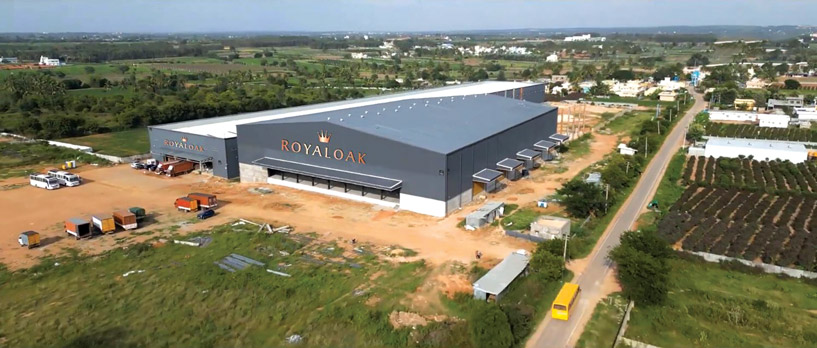
The Indian Government has already identified the furniture sector as a crucial sector to drive the Indian economy; having said that the road ahead needs to be traversed in a planned and strategic way. The strategies for competitiveness will range from cluster-based development to technical expertise and sustainable growth, Furniture Design & Technology (FDT) reports.
The landscape of India’s furniture industry is currently experiencing a transformative phase, presenting a mix of challenges and opportunities. Strategic initiatives, adaptability, technological changes, and global support for developing countries all play a role in shaping the industry’s future. The question of whether India can become a readymade furniture hub depends on its ability to navigate these dimensions strategically for sustained growth and global competitiveness.
.jpg)
Addressing challenges and leveraging opportunities are central to India’s vision of becoming a global hub for ready-made furniture. Sonakshi Taneja, Co-Founder of Dimensions and Vijai Subramaniam, Founder & Chairman, Royaloak Furniture collectively identifies challenges such as ensuring consistent quality standards, addressing logistical complexities, and overcoming global competition. However, opportunities lie in leveraging skilled craftsmanship, adopting efficient manufacturing processes, and capitalizing on the growing demand for diverse and affordable furniture options. Strategic partnerships, technological integration, and sustainable practices are seen as crucial for overcoming challenges and positioning India as a competitive force in the international ready-made furniture market.

Neetii Maacker, Co-Founder, The Homemakers insights provide a nuanced perspective on challenges and opportunities within the Indian furniture industry. She emphasizes that apart from building a proficient workforce and a seamless integration with modern manufacturing tools and techniques, the importance of adhering to global quality standards is the need of the hour. Challenges arising from the unorganized nature of the industry and the lack of strong industry representation is also a reason to worry about. However, she also acknowledges India’s growing reputation globally, propelled by government initiatives such as “Make in India,” “Skill India,” and “Atmanirbhar Bharat.”
Ashish Jain, Director at Madewithspin points out that despite improvements since 2014, addressing a spectrum of challenges in the furniture industry remains crucial. The supply scene, though progressing, is still at a nascent stage compared to other countries. High raw material costs and concerns about their quality persist in India, leading manufacturers to source materials from countries like China and Taiwan to offer cost benefits to end-users. Jain underscores the stringent quality protocols abroad, where there’s no room for error, highlighting the need to follow a standardized benchmark for quality in India. He advocates for manufacturers to prioritize quality as a key aspect of their product portfolio to meet international standards.
Speaking on the raw material challenge Deepika Goyal, Director, Popcorn Furniture states that in their organization, they actively address this challenge by maintaining a dedicated team of at least three individuals constantly seeking out new suppliers. The surge in demand for raw materials in India has led to delays in procurement, with materials like particle board or MDF board, which used to take one week to obtain, now stretches to 10 to 12, sometimes even 15 days. To address this situation, her company has adopted a prudent approach of dealing with multiple suppliers, ensuring a backup plan in case one supplier faces delays, allowing them to maintain a seamless workflow.
She further adds that logistics pose a significant challenge for them, especially in high-end residential projects where furniture is transported in a knockdown condition and has to be assembled on site. In such cases, ensuring proper handling by logistics companies is paramount, and inadequate packaging can result in damaging pieces. This challenge is further intensified when exporting furniture, making the process considerably more complex.
A critical aspect highlighted by Neetii and Sonakshi is the imperative to enhance technical expertise in the furniture manufacturing sector. Taneja underscores the importance of partnerships between industry and academia, comprehensive training programs, and collaborations for technology transfer with global experts. Meanwhile, Neetii stresses on the use of modern manufacturing tools, techniques, and technology in design and production. This collective emphasis aims to drive innovation and enhance competitiveness within the industry.
Deepika emphasizes the crucial role of top-notch machinery in crafting high-quality products. According to her, the end result’s superior finish is directly tied to the quality of the machinery used in the manufacturing process. Achieving excellence in product design is equally vital for longevity and functionality. Ms. Goyal points out that the challenge of securing the right machinery for manufacturing and the importance of a well-thought-out design is a crucial one. In the realm of industrial products like furniture, unless it’s handmade, skilled labor becomes pivotal. Hence at Popcorn, she adds significant investments were made to utilize state-of-the-art machinery imported from Germany. This, in turn, had a key role to play in the company’s success in delivering fine products which also have laid a profound emphasis on design.
Subramaniam says furniture manufacturing in India has a long history, but the majority of manufacturing units contribute to the unorganized sector, which accounts for approx 97% of the Indian furniture market. Additionally, many manufacturers sell white-labeled goods. Hence India, he adds, should pivot towards creating a more organized sector within the manufacturing industry. This shift is not only crucial to cater to the country’s vast population of 1.4 billion but also get access to better capital. To achieve this, there needs to be a concerted effort to transition more manufacturing units from the unorganized sector to the organized sector. Drawing inspiration from China and other Asian countries, India should focus on current trends and modernize its manufacturing units.
.jpg)
Access to capital emerges as a bottleneck for many furniture manufacturers in India agrees Taneja, she proposes strategic initiatives such as optimizing loan procedures, introducing targeted financial support initiatives, and collaborating with financial institutions for customized lending solutions. This approach is designed to facilitate better financial support for manufacturers, creating an environment conducive to sustained growth within the furniture manufacturing sector.

INDIA’S COMPARATIVE ADVANTAGE AND ENHANCING VALUE ADDITION IN EXPORTS:
While acknowledging China’s manufacturing prowess, Sonakshi believes India’s comparative advantage lies in skilled craftsmanship, a rich design heritage, and a cost-effective workforce. The focus on customization, sustainable practices, and a growing global design appeal positions India uniquely in the global furniture market. Despite infrastructure challenges, India’s evolving strengths make it a compelling player on the international stage. Taneja’s strategy for enhancing value addition in Indian furniture exports encompasses a multifaceted approach. This includes embracing cutting-edge design trends, incorporating sustainable practices, leveraging advanced manufacturing technologies, and establishing strategic partnerships throughout the supply chain. The holistic strategy aims not only to meet global demand but also to position Indian furniture as eco-friendly and contemporary, thereby strengthening India’s global reputation.
The allure of sourcing furniture from India for international buyers is multifaceted, encompassing various compelling factors. Maacker says “The world is warming up to India, and we are being noticed for our great craftsmanship. India can supply durable and exquisite designer furniture at affordable rates. The demand for such pieces is on the rise in international markets, where people are looking for sleek, modern, affordable furniture on one hand, and bespoke, designer collections on the other.”
Moreover, India’s diversity in design aesthetics sets it apart as a captivating destination for global furniture procurement. Likewise India’s growing emphasis on sustainability further elevates its appeal in the global marketplace. The Indian furniture industry is aligning itself with sustainable production methods, including responsibly sourced raw materials and environmentally conscious manufacturing processes, in response to the global shift towards ethically produced and environmentally friendly goods.
This flexibility in design and production Indian furniture manufacturers provide allows international buyers to engage in collaborative ventures, tailoring furniture pieces to meet specific requirements and preferences. The ability to create bespoke furniture underscores India’s commitment to providing a personalized and tailored experience for its global clientele. Hence despite the challenges inherent in any global market, these factors collectively contribute to India’s enduring appeal for international buyers seeking quality, diversity, and craftsmanship in their furniture offerings.

To align with the branding standards typically invested in by Italian and French furniture makers, Ashish emphasizes the importance of embracing the omni-channel approach, a strategy that resonates with evolving global trends. Social media, especially Instagram, plays a crucial role in driving online sales.
Customers often discover the brand on these platforms and subsequently visit the experience store. Jain highlights the importance of seamlessly integrating various technologies like AR and VR into the website, providing customers with the ability to visualize spaces online. This flexibility allows customers to make a purchase decision either on the website or by visiting the store, consulting with a designer, and placing the order in-person. According to Jain, omni-channel is undoubtedly the way forward, and relying solely on online channels is insufficient, especially in the furniture industry, where first hand experience is essential. He notes that customers, even those who initially discover the brand online, often visit the store. Many a times they do change their decision-making process after visiting the store. Hence akin to international brands furniture manufacturers should invest in creating a retail experience as well.


Both Taneja and Subramaniam underscore the pivotal role of government support in fostering the growth of the furniture industry. Sonakshi recommends streamlining regulations, offering financial incentives for sustainability, and investing in skill development programs. Subramaniam suggests a unified platform for exports and procurement, incentives to manufacturers, and robust communication platforms to enhance awareness and promotion of the sector. These measures collectively aim to create a favorable business environment and encourage growth in the industry. Jain highlights the significance of major furniture fairs like Salone Del Mobile and IMM Cologne, emphasizing their impact as platforms where the entire world converges to showcase their products. He notes the remarkable growth of the middle class in India, resulting in increased purchasing power, making it an opportune time to host a fair of similar magnitude. He sees these large-scale events as beneficial for Indian designers, providing a boost when showcasing their offerings to an international audience. While acknowledging existing smaller fairs in India, he points out the need for a fair on a grander scale, comparable to international standards. Jain recognizes efforts by spaces like Pragati Maidan in Delhi and Yashobhoomi in Noida to match up, expressing the desire for a comprehensive Indian fair that serves as a conglomeration of both Indian and international designers and brands.

The comprehensive exploration of India’s furniture industry illuminates a transformative landscape poised for global competitiveness. The challenges and opportunities in evolving into a ready-made are many; from addressing logistical intricacies to leveraging India’s comparative advantages, the industry maps a trajectory towards international recognition. Tackling challenges in raw material procurement and enhancing technical expertise are crucial steps, accompanied by a call to embrace new-age technologies. Government support and inception of fairs of the global kind emerge as key drivers. As India navigates these strategic pathways, the unfolding journey promises a compelling narrative of growth, innovation, and potential dominance in the global furniture market.
Furniture Design India and the magazine FURNITURE DESIGN & TECHNOLOGY (FDT magazine) are from the trusted 22-year-old media house of SURFACES REPORTER and PLY REPORTER.
FDT is a B2B monthly bilingual magazine from India that shares the pulse of the furniture business in India and connects the manufacturers, OEMS, product designers, architects, showrooms, designers and dealers.
Read More© 2025 Furniture Design and Technologies.. All Rights Reserved. Developed by eyeQ Advertising